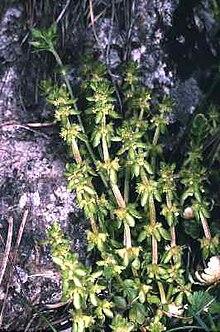Valantia
| Valantia | ||||||||||
|---|---|---|---|---|---|---|---|---|---|---|

Stiff-haired rubble ( Valantia hispida ) |
||||||||||
| Systematics | ||||||||||
|
||||||||||
| Scientific name | ||||||||||
| Valantia | ||||||||||
| L. |
Valantia , German trivial name debris herbs is a genus within the family of the Rubiaceae (Rubiaceae).
Description and ecology
Vegetative characteristics

Valantia species are mostly annual herbaceous plants that reach heights of up to 30 centimeters. The upright to prostrate, sometimes branched stems are more or less hairy, angular and fleshy; they are sometimes tinged with red. Valantia TYPES sometimes form a taproot from.
The whorled leaves , usually in threes or fours, are stalked or sessile. The simple, entire, small, fleshy leaf blades are elliptical, ovate or obovate with a rounded to pointed or pointed upper end. The leaf blades are glabrous to slightly hairy, ciliate. The leaf nerve consists of a clearly visible main vein and very weak side veins.
Generative characteristics


Many flowers stand together in lateral, short, zymous inflorescences . There can be just as many bracts . The flower stalks are short.
The relatively small, hermaphrodite or male flowers are radial symmetry and three to four-fold. There are no sepals. The three or four bald, more or less overgrown petals are greenish, yellow to slightly reddish. There are three or four stamens that have grown alternately on the perigone. The plant specimens can be protandric . The male flowers are arranged laterally next to the hermaphrodite flowers. The male flowers can sometimes have a rudimentary ovary .
The lower, two- chamber ovary contains two ovules . The two branches of the style end in heady scars .
The smooth to papillae and brownish to blackish partial fruits when ripe are round to kidney-shaped with a diameter of 1 to 2 millimeters. Often only one partial fruit is formed, but the fruits can also contain two. Raphids (whitish, needle-shaped calcium oxalate crystals ) may be present in the hilum region of the partial fruits . The compressed pericarp is leathery. The seeds are rounded.
The fruits are completely or partially covered by a smooth to more or less bristly, or also with hooked outgrowths, also horny or rarely beaked, tight to lightly fitting "fruit corpus", which results from the fusion of the growing inflorescence stalk with the flower stalks . The "fruit corpus" is greenish, yellowish to reddish with whitish to yellowish hair, bristles or appendages. The diaspores are epichoric or, rarely, anemochoric ; it is mostly autogamy , but rarely allogamy .
The number of chromosomes is 2n = 18, 22, 36 or 40.
Systematics and distribution
The genus Valantia was established by Carl von Linné . The generic name Valantia honors the French doctor and botanist Sébastien Vaillant (1669-1722). Synonyms for Valantia L. are: Meionandra Gauba , Vaillantia Hoffm. orth. var.
The genus Valantia belongs to the tribe Rubieae in the subfamily Rubioideae within the Rubiaceae .
The genus Valantia includes seven species that are mainly distributed in the Mediterranean area, but they also reach the Macaronesian and Irano-Turanian flora :
- Large rubble ( Valantia aprica (Sm.) Boiss. & Heldr. ): It occurs from southern Albania to western and southern Greece and on Crete.
- Linosa rubble ( Valantia calva Brullo ): It occurs only on the island of Linosa .
- Valantia columella (Ehrenb. Ex Boiss.) Soon. : It occurs in Egypt and northern Libya.
- Valantia deltoidea Brullo : It occurs only on the Rocca Busambra in northern Sicily.
- Stiff-haired rubble ( Valantia hispida L. ): It occurs in two varieties in the Canary Islands and from the Mediterranean region to western Asia and to northeastern tropical Africa.
- Valantia lainzii Devesa & Ortega Oliv. : It occurs only in southern Spain.
- Wall rubble ( Valantia muralis L. ): It occurs in two varieties in the Mediterranean region.
literature
- M. Aiello, S. Brullo, V. Piccione: Numerical analysis applied to the taxonomy of the genus Valantia L. (Rubiaceae). In: Anales del Jardín Botánico de Madrid. Volume 37, Issue 2, 1980, pp. 577-586, online (PDF).
- John Wilkes: Encyclopaedia Londinensis. Volume XXIV, London 1829, p. 221, col. 2.
Web links
- Genus: Valantia (debris herb) on mittelmeerflora.de , accessed on July 18, 2018th
Individual evidence
- ^ Juan A. Devesa, Ana Ortega-Olivencia: A new species of Valantia (Rubiaceae) from Spain. In: Botanical Journal of the Linnean Society. Volume 143, Issue 3, 2003, pp. 331-335, doi: 10.1046 / j.1095-8339.2003.00226.x .
- ↑ John Hill: A General Natural History. Volume II, London 1751, p. 633, online at e-rara.ch, ETH-Zürich, ETH-Bibliothek, accessed on July 18, 2018, doi: 10.3931 / e-rara-20218 .
- ↑ Alex Casha: Flora of the Maltese Islands. Lulu, 2017, ISBN 978-0-244-60588-9 , p. 186.
- ^ TG Tutin, VH Heywood et al .: Flora Europaea : Plantaginaceae to Compositae (and Rubiaceae). Volume 4, Cambridge Univ. Press, 1976, ISBN 0-521-08717-1 , p. 37 f.
- ↑ Lotte Burkhardt: Directory of eponymous plant names . Extended Edition. Botanic Garden and Botanical Museum Berlin, Free University Berlin Berlin 2018. [1]
- ↑ a b c d e f g h i Rafaël Govaerts (ed.): Valantia. In: World Checklist of Selected Plant Families (WCSP) - The Board of Trustees of the Royal Botanic Gardens, Kew . Retrieved November 4, 2018.
